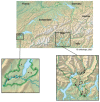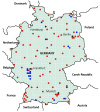European surveillance for West Nile virus in mosquito populations
- PMID: 24157510
- PMCID: PMC3823308
- DOI: 10.3390/ijerph10104869
European surveillance for West Nile virus in mosquito populations
Abstract
A wide range of arthropod-borne viruses threaten both human and animal health either through their presence in Europe or through risk of introduction. Prominent among these is West Nile virus (WNV), primarily an avian virus, which has caused multiple outbreaks associated with human and equine mortality. Endemic outbreaks of West Nile fever have been reported in Italy, Greece, France, Romania, Hungary, Russia and Spain, with further spread expected. Most outbreaks in Western Europe have been due to infection with WNV Lineage 1. In Eastern Europe WNV Lineage 2 has been responsible for human and bird mortality, particularly in Greece, which has experienced extensive outbreaks over three consecutive years. Italy has experienced co-circulation with both virus lineages. The ability to manage this threat in a cost-effective way is dependent on early detection. Targeted surveillance for pathogens within mosquito populations offers the ability to detect viruses prior to their emergence in livestock, equine species or human populations. In addition, it can establish a baseline of mosquito-borne virus activity and allow monitoring of change to this over time. Early detection offers the opportunity to raise disease awareness, initiate vector control and preventative vaccination, now available for horses, and encourage personal protection against mosquito bites. This would have major benefits through financial savings and reduction in equid morbidity/mortality. However, effective surveillance that predicts virus outbreaks is challenged by a range of factors including limited resources, variation in mosquito capture rates (too few or too many), difficulties in mosquito identification, often reliant on specialist entomologists, and the sensitive, rapid detection of viruses in mosquito pools. Surveillance for WNV and other arboviruses within mosquito populations varies between European countries in the extent and focus of the surveillance. This study reviews the current status of WNV in mosquito populations across Europe and how this is informing our understanding of virus epidemiology. Key findings such as detection of virus, presence of vector species and invasive mosquito species are summarized, and some of the difficulties encountered when applying a cost-effective surveillance programme are highlighted.
Figures



References
-
- Ciccozzi M., Peletto S., Cella E., Giovanetti M., Lai A., Gabanelli E., Acutis P.L., Modesto P., Rezzam G., Platonov A.E., et al. Epidemiological history and phylogeography of West Nile virus lineage 2. Infect. Gen. Evol. 2013;17:46–50. - PubMed
Publication types
MeSH terms
Grants and funding
LinkOut - more resources
Full Text Sources
Other Literature Sources
Medical

